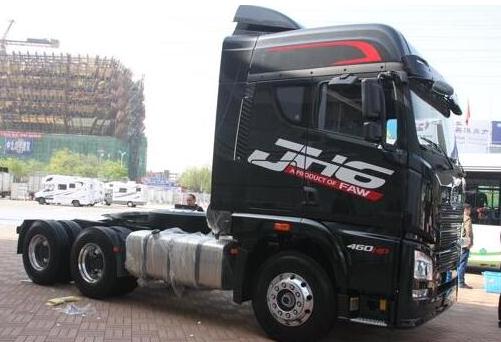As a global automobile event with extensive international influence, although the Beijing Auto Show is dominated by passenger cars, commercial vehicles are also an important supporting role. At the current Beijing auto show site, the author discovered that the commercial vehicle industry is quietly undergoing some new changes by visiting the commercial vehicle exhibition area and the exchanges with corporate stakeholders.
At present, China’s auto industry is entering a “new normal†where growth is slowing down. The commercial vehicle market is also becoming sluggish with the general environment and the industry is in a critical period of transformation and upgrading. In the past two years, as the overall level of China's commercial vehicle industry has increased, the competition among manufacturers has gradually shifted from low-end price wars to high-end value wars, and high-quality products have emerged. How to provide users with more product value has become the focus of more and more companies, which can be seen in the current Beijing auto show.
The first is intelligence. At the auto show scene, the smartest manifestation is the Futian Internet Super Truck series, which includes three types of light trucks, medium trucks and heavy trucks. The super truck with the core of the Internet of Vehicles has become one of the representatives of the truck's intelligence through a number of technologies, including assisted driving systems, fleet management, and cargo matching. In addition, at the auto show, Dongfeng Liuzhou Automobile and LeTV Vehicles have reached a strategic alliance for smart interconnection to jointly create a smart interconnected “cloud truck†to achieve interoperability among trucks, people and information. Intelligent network integration of vehicles can further increase the amount of information processing, and the entire vehicle electronic system extends to the “human-vehicle-environment†stereoscopic information processing, which can significantly improve driving safety and convenience, which will become the future of commercial vehicles. development trend.
Followed by high-end. The gradual upgrading of products is a problem that China's commercial vehicle companies must face in the development. This is due to the pressure of market competition. On the other hand, it is inevitable for the development of commercial vehicle companies. At the same time, with the rapid development of the domestic logistics market, in order to effectively improve transport efficiency and reduce costs, the direction of the development of the logistics and transportation industry has gradually shifted from simplification to intensive. Under this trend of development, it is particularly important for commercial vehicle companies to transform and upgrade. For trucks that are used as means of production, they also need to shift from the low-end economy to the mid-to-high end. In this auto show, high-end models such as Sichuan Modern high-end light truck QTc, Beiben V3ET high-efficiency version of logistics tractor, Liuqi high-end long head truck T7, Futian Auman EST and other high-end models have appeared one after another, regardless of safety, reliability, or In terms of efficiency and comfort, it has greatly improved over the past. These mid-to-high-end truck products not only meet the requirements of energy conservation and environmental protection, but also reduce the cost of vehicles and increase the efficiency of use. They will be welcomed by more and more users in the future.

Liberate JH6 heavy truck
The third is electric. Today, energy conservation and environmental protection have become important challenges for the development of the automotive industry. Coupled with the strong support of China’s policies, new energy vehicles will become an important component of the automobile industry in the country. Many commercial vehicle companies are actively conducting new energy products. The full-line layout accelerates the development of new energy automotive products. In the auto show area of ​​this auto show, representatives of FAW, Dongfeng, JAC, Nanjing Iveco and other companies, from light passengers, light trucks, China Card, to city buses and special vehicles, all have pure electric products, which has been exhibited in previous auto shows. Not much to see.
Although in the current auto show, the author saw a welcome change in the commercial vehicle industry, but unfortunately found that more and more commercial vehicle companies fade out of the Beijing Auto Show stage. Judging from the exhibitors of commercial vehicles announced by the organizers this year, many domestic commercial vehicle companies, including heavy truck, Shaanxi Auto, Hualing, Dayun and other truck companies, have not exhibited, and the mainstream bus companies have not shown up as they always did; Truck companies have not made any appearances. This and the commercial vehicle exhibition area are mainly concentrated outdoors, and visitors pay more attention to passenger cars, and there is a great concern for the relatively small degree of concern for commercial vehicles. For commercial vehicle companies, if they can not achieve the expected results, they will naturally shift to more professional exhibitions. The absence of many commercial vehicle companies has made this Beijing Auto Show less of a point of view and it is difficult to fully demonstrate the changes in the industry. Compared to last year's Shanghai Auto Show, the attraction of the Beijing Auto Show for commercial vehicle companies is gradually weakening, and the commercial body shadow is gradually drifting away.
Reactive Dyes Thickening Agent
A reactive dye Thickening Agent is a substance used in the textile industry to enhance the viscosity of reactive dye solutions, making them easier to handle and apply. Reactive dyes are known for their high affinity to cellulose fibers, such as cotton, but they can sometimes be difficult to work with due to their low viscosity. The addition of a thickening agent helps to stabilize the dye solution, improving its flow properties.
There are various types of thickening agents that can be used depending on the specific requirements of the dyeing process:
1. **Cellulose Derivatives**: These include materials like carboxymethyl cellulose (CMC), hydroxypropyl methyl cellulose (HPMC), and others. They form a gel-like structure when dissolved in water, which increases the viscosity of the dye solution.
2. **Polyacrylates**: These are synthetic polymers that can be used to increase the viscosity of reactive dye solutions. They provide good stability and are often used in conjunction with other thickeners.
3. **Polysaccharides**: Natural polymers such as starch or xanthan gum can also serve as effective thickening agents in reactive dye solutions.
4. **Polyvinyl Alcohol (PVA)**: PVA is another synthetic polymer that can increase the viscosity of reactive dye solutions, making them more manageable during the dyeing process.
When using a thickening agent, it's important to consider factors such as the type of fiber being dyed, the desired level of viscosity, and any potential interactions between the thickener and other components of the dye bath. Proper dosing is crucial to achieve the optimal thickening effect without compromising the colorfastness or the overall quality of the finished product.

Water-based Paint Thickener, Reactive Dyes Printing Thickener, Silica Thickener,Liquid Thickener,Thickening Agent For Liquids
Guangzhou Quanxu Technology Co Ltd , https://www.anticorrosionpigment.com